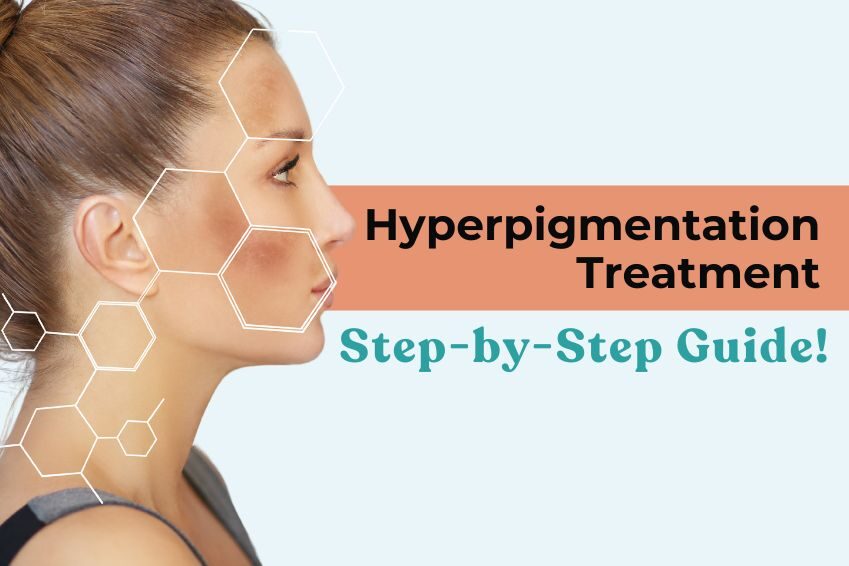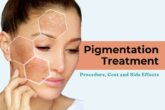
Skin darkening caused by too much melanin pigment is known as hyperpigmentation. Melanocytes are specialized skin cells that produce more melanin pigment when exposed to sunlight. The Hyperpigmentation treatment in Delhi helps in treating skin’s outermost layer darkens and tans. Freckles are dark pigmentation patches caused by uneven melanin synthesis. Rarely, skin darkening can be caused by substances other than melanin.
Hyperpigmentation is a term used to describe darker-looking skin, not necessarily a medical condition. It is capable of:
- Occur in tiny patches
- Cover a lot of ground
- Impact the body as a whole
Types of Hyperpigmentation
Melasma, sunspots, and post-inflammatory hyperpigmentation are the most common forms of hyperpigmentation, though there are other varieties as well.
- Melasma: Melasma may appear during pregnancy and is thought to be brought on by hormonal changes. Although hyperpigmentation can occur anywhere on the body, the face and stomach are the most frequently affected areas.
- Sunspots: Sunspots, frequently referred to as liver spots or solar lentigines, are caused by prolonged exposure to too much sun and typically appear as spots on sun-exposed areas such as the face and hands.
- Inflammation-induced hyperpigmentation: It is caused by skin damage or inflammation. Acne is a common cause of this kind.
All these types of pigmentation are treated by the Hyperpigmentation treatment in Delhi.
Signs and symptoms of Hyperpigmentation
Patches of hyperpigmentation, which vary in size and shape, are visible. Depending on the kind of hyperpigmentation, they can appear anywhere on the body.
Typical signs Hyperpigmentation treatment in Delhi consist of
- Dark spots on the skin that are sunspots
- Patches of pigmentation
- Skin discoloration following inflammation
- Raised dark patches
Why does hyperpigmentation occur?
Excess melanin production is a common cause of hyperpigmentation. The pigment that gives skin its color is called melanin. Melanocytes, which are skin cells, produce it. Your body can produce melanin differently depending on a number of different conditions or factors. Hyperpigmentation may result from certain medications. Additionally, Hyperpigmentation treatment near me may be a side effect of certain chemotherapy medications.
Melanin production in some women can be impacted by pregnancy, which also alters hormone levels. The hyperpigmentation caused by Addison’s disease, a rare endocrine condition, is most noticeable on the face, neck, and hands, as well as on the elbows and knees, which are exposed to friction. A hormone level in your body causes an increase in melanin synthesis, which is the direct cause of hyperpigmentation.
In what ways is hyperpigmentation identified and managed?
A Hyperpigmentation treatment in Delhi can determine the cause of your Hyperpigmentation in Delhi. To ascertain the cause, they will ask about your medical history and perform a physical examination. A skin biopsy may be able to identify the cause in certain situations. Certain cases of hyperpigmentation can be treated with topical prescription medication. Typically, this drug contains hydroquinone.
However, ochronosis, or skin darkening, can result from consistently using topical hydroquinone without taking any breaks. Therefore, topical hydroquinone should only be used under a dermatologist’s supervision so that they can appropriately advise you on how to use the drug without experiencing any negative side effects.
Dark spots on the skin can also be lightened by applying topical retinoids.
It may take several months for darkened areas to lighten with either of these medications.
Sunscreen use is another aspect of home care. The most crucial element in addressing the majority of hyperpigmentation causes is sunscreen. Seek out:
Zinc oxide should ideally be the primary active ingredient in a physically blocking sunscreen.
Apply sunscreen every day. If you’re in the sun, reapply it every two hours; if you’re swimming or perspiring, apply it more frequently.
Visible light may also contribute to the persistence of hyperpigmentation in certain skin conditions, like melasma.
To block some visible light, look for a mineral sunscreen that also contains iron oxide. Use it every day. Wear clothing with an SPF to protect yourself from the sun.
Additional Hyperpigmentation treatment in Delhi
The cause and severity of Hyperpigmentation treatment near me determine how hyperpigmentation is treated.
Chemical peels
To treat discolored skin, a chemical peel entails applying a chemical solution to the skin and removing the outermost layers. This Hyperpigmentation treatment in Delhi procedure resurfaces the skin. Chemical peels can be light, deep, or any combination of these, depending on the pigmentation depth.
Microdermabrasion
The minimally invasive procedure known as microdermabrasion, which involves epidermal resurfacing, is used to treat scars, including acne scars, photoaging, sun damage, melasma, and uneven skin tone and texture. When combined with oral or topical medications, it is considered an effective treatment for skin conditions such as melasma.
IPL/intense pulsed light
Intense Pulsed Light uses laser energy to target and destroy damaged or pigmented skin cells. IPL can be used to treat a range of skin issues. Here are a few Hyperpigmentation treatment near me:
- Acne scars
- Excessive pigmentation
- Freckles of Melasma
- Sun damage
- Resurfacing with laser
Use of cryotherapy
Cryotherapy destroys the cells that produce skin pigment, leaving the treatment site permanently pale. In cryotherapy, abnormal tissue is frozen and removed using extremely cold temperatures. Dermatologists recommend cryotherapy for many skin conditions.
Skin creams
The majority of prescription skin-lightening treatments contain hydroquinone. With the help of bleaches, dark spots on the skin can gradually lighten and disappear because they slow down the synthesis of melanin. Melanin production is slowed down by our bleaches, which lighten and gradually fade darkened skin patches. Compared to over-the-counter bleaches, prescription bleaches contain twice as much hydroquinone, the active ingredient.
Conclusion
Hyperpigmentation is very common because of the amount of time spent in the sun. Dark spots are treatable, so those who have them need not worry. The Hyperpigmentation treatment near me is the main preventive measure to exercise caution by staying out of the sun and wearing sunscreen. A person is not defined by their facial features. It is always possible to be confident in one’s skin, regardless of the changes one experiences with it.
Truth About Hyperpigmentation treatment

